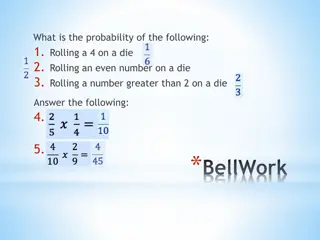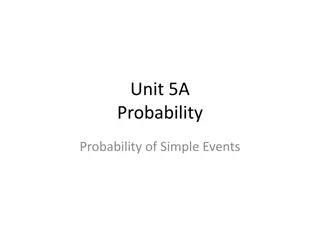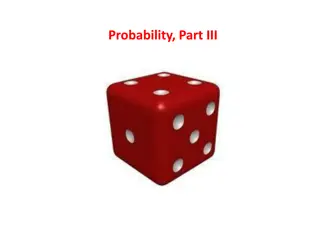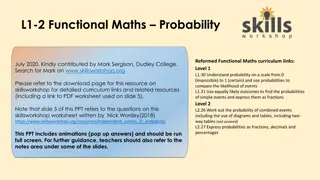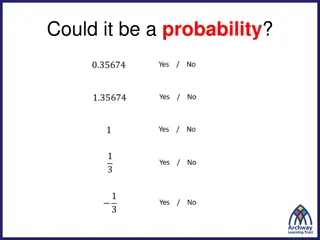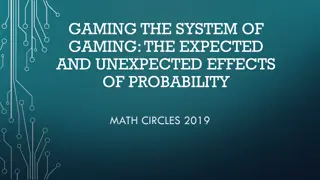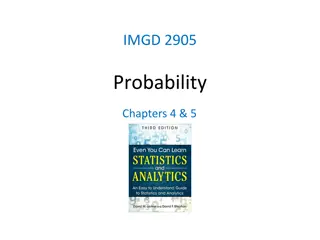Exploring Probability Through Equally Likely Games in Remote Learning
Engage students in investigating statistical outcomes of games to enhance their understanding of probability concepts. The task involves learning and playing two games, analyzing data to make predictions and calculate probabilities. Teachers can utilize remote learning strategies, such as asynchronous and synchronous delivery, to facilitate collaborative learning experiences. Key skills include describing fair game outcomes, assigning probabilities, and connecting fractions, decimals, and percentages. Students are encouraged to document their work and submit reflections for feedback.
- Probability Concepts
- Remote Learning Strategies
- Equally Likely Games
- Statistical Analysis
- Collaboration
Download Presentation

Please find below an Image/Link to download the presentation.
The content on the website is provided AS IS for your information and personal use only. It may not be sold, licensed, or shared on other websites without obtaining consent from the author. Download presentation by click this link. If you encounter any issues during the download, it is possible that the publisher has removed the file from their server.
E N D
Presentation Transcript
EQUALLY LIKELY GAMES: RIME For remote learning
RIME : EQUALLY LIKELY GAMES? Key premise: In this task, students will Investigate the statistical outcomes of two games. Use data to form predictions and calculate probabilities. TEACHER GUIDE: TASK OVERVIEW Task requirements: Students will be required to Learn and play two games. Record and use results to form conclusions. Key skills, strategies and understandings: Students will be able to Describe possible outcomes if a game is fair. Assign probabilities to outcomes of events.
TEACHER GUIDE: REMOTE LEARNING CHALLENGES AND STRATEGIES Asynchronous delivery Synchronous delivery Using games as the basis for mathematical exploration, this task introduces students to probability concepts. Students collaborate and communicate with each other Buddy students up to work together via email or across communication platforms. Use chat features in Webex for students to work together. Use online platforms for students to collaborate on journaling e.g. Google Docs, OneNote. Student feed back their understanding to the teacher Use online tools such as Google Forms students submit answers to questions in their own time. Use of school LMS systems submission of ideas. Use Google Docs or OneNote strategy mentioned above teacher will be able to see what students are doing in real time and provide feedback. Students collect and analyse data, and from this, form conclusions about equal chance . Students document their work If using offline hard copy journals, students can take photos and send these to the teacher. Students are encouraged to collaborate and can work together on this lesson in a remote learning environment. Students submit their work for teacher feedback Students submit their completed journal through either email or a communication platform.
TEACHER GUIDE: REMOTE LEARNING CHALLENGES AND STRATEGIES For this task, students are encouraged to collaborate by: sharing results in pairs via virtual communication e.g. Webex working together to investigate the statistical properties of games. documenting their work using tables and taking photos of their investigations. indicating their understanding by recording reflections. submitting their predictions, results tables, any photos and their reflections to the teacher.
TEACHER GUIDE: LINKS TO THE CURRICULUM Curriculum strand(s) Statistics & Probability, Number & Algebra Key learning outcomes: Describe possible outcomes if a game is fair. Assign probabilities to outcomes of events. Curriculum sub- strand(s) Chance, Real Numbers Level addressed 7 What would be some common misconceptions or difficulties that teachers need to keep an eye out for? Students may require support to complete their table of data and convert frequencies to fractions, decimals and percentages. Students may require support to understand why conclusions about fairness may change after more games have been played (i.e. when there is more data to use for basing a prediction). If so, discuss whether they would expect the results of each five games to always be the same. Compare actual results for each set of five with the first five games. Construct sample spaces for single-step experiments with equally likely outcomes (VCMSP266) Assign probabilities to the outcomes of events and determine probabilities for events (VCMSP267) Connect fractions, decimals and percentages and carry out simple conversions (VCMNA247)
TEACHER GUIDE: GAME 2 GUIDE Before the investigation, students must decide: How they will determine if each outcome is equally likely. After having played a round of Twelve, students will see that you can either win or lose the game. There are no other possible outcomes. If each outcome is equally likely, then you would expect Player 1 and Player 2 to each win 50% of the time. How they will keep track of whether Player 1 or Player 2 wins each game. Using a table with a tally that records each outcome will be most helpful here. After the investigation, students will discuss and/or reflect on: What their results show, and whether the games they have played, games of strategy or luck. After playing Twelve a number of times, students may notice that there are certain numbers that are safe to land on, i.e. 12, 7 and 2. This shows that there is some strategy involved in playing the game. Note one circumstance where 2 is not a safe number: if Player 1 takes 2 and the Player 2 takes 3 each time in response, Player 1 will run out of 2s. This set of moves will actually allow Player 2 to win.
STUDENT SLIDE 1: EQUALLY LIKELY GAMES? The problem: Heads I win, tails you lose! Is that coin toss fair? Some games give everyone an equal chance of winning but some games don t. You re going to explore two games one s a classic and one is likely to be new and see what s going on. Learning intentions Know how to use actual data to calculate probabilities. Identify if a game is fair. Success criteria Learn and play two games. Record game results. Explain findings from your results. Equipment needed Paper Pen/pencil Shared whiteboard (if playing remotely)
STUDENT SLIDE 2: EQUALLY LIKELY GAMES? If I toss heads I win, If you toss tails you lose. Is this fair? Why?
STUDENT SLIDE 3: EQUALLY LIKELY GAMES? If I roll an even I win, if you roll an odd I lose. Is this fair? Why? SOURCE: Glen Carrie, Unsplash
STUDENT SLIDE 4: EQUALLY LIKELY GAMES? If I roll a multiple of 2 I win, if you roll a multiple of 3 you win. Is this fair? Why? SOURCE: Glen Carrie, Unsplash
STUDENT SLIDE 5: EQUALLY LIKELY GAMES? Some games are fair. Some games are not!
STUDENT SLIDE 6: EQUALLY LIKELY GAMES? GAME 1: NOUGHTS & CROSSES
STUDENT SLIDE 7: EQUALLY LIKELY GAMES? GAME 1: NOUGHTS & CROSSES In noughts and crosses, you can either: win, lose, or draw.
STUDENT SLIDE 8: EQUALLY LIKELY GAMES? GAME 1: NOUGHTS & CROSSES In noughts and crosses, you can either: win, lose, or draw. Do you think it is a fair game? If it is fair, what fraction of the time would you expect to get each outcome?
STUDENT SLIDE 9: EQUALLY LIKELY GAMES? GAME 1: NOUGHTS & CROSSES Let s see what happens. 1. Play 5 games of Noughts & Crosses. Record the results in this table, like this if Player 1 wins... Tally Player 1 wins Player 2 wins Draw Total
STUDENT SLIDE 10: EQUALLY LIKELY GAMES? GAME 1: NOUGHTS & CROSSES Let s see what happens. 1. Play 5 games of Noughts & Crosses. Record the results in this table, like this if Player 2 wins... Tally Player 1 wins Player 2 wins Draw Total
STUDENT SLIDE 11: EQUALLY LIKELY GAMES? GAME 1: NOUGHTS & CROSSES Let s see what happens. 1. Play 5 games of Noughts & Crosses. Record the results in this table, like this if there is a draw... Tally Player 1 wins Player 2 wins Draw Total
STUDENT SLIDE 12: EQUALLY LIKELY GAMES? GAME 1: NOUGHTS & CROSSES Let s see what happens. 1. Play 5 games of Noughts & Crosses. Record the results in this table. Tally Player 1 wins 2. If you played many more games, will the results of each five games always be the same? Discuss with a classmate. Player 2 wins Draw Total
STUDENT SLIDE 13: EQUALLY LIKELY GAMES? GAME 1: NOUGHTS & CROSSES Let s see what happens. 1. Play 5 games of Noughts & Crosses. Record the results in this table, Tally Player 1 wins 2. If you played many more games, will the results of each five games always be the same? Discuss with a classmate. Player 2 wins Draw 3. Play the game another 5 times, to make a total of 10. Record what happens in your table. Total
STUDENT SLIDE 14: EQUALLY LIKELY GAMES? GAME 1: NOUGHTS & CROSSES You ve now played 10 games. Frequency Fraction Decimal Percent 4. Complete the table to show what fraction of the time you got each outcome. e.g. if Player 1 won 6 games, then the results would be 6 10 for the fraction, 0.6 for the decimal and 60%. Player 1 wins Player 2 wins Draw Total
STUDENT SLIDE 15: EQUALLY LIKELY GAMES? GAME 1: NOUGHTS & CROSSES You ve now played 10 games. Frequency Fraction Decimal Percent 4. Complete the table to show what fraction of the time you got each outcome. e.g. if Player 1 won 6 games, then the results would be 6 10 for the fraction, 0.6 for the decimal and 60%. Player 1 wins Player 2 wins Draw 5. Compare your findings with classmates. Do the three outcomes seem equally likely? Total
STUDENT SLIDE 16: EQUALLY LIKELY GAMES? GAME 2: TWELVE
STUDENT SLIDE 17: EQUALLY LIKELY GAMES? GAME 2: TWELVE How to play: 1. Two players take turns crossing out numbers from this set and saying the total that s crossed out: 1 2 3 4 1 2 3 4 2. You win if you either: get exactly 12, or force your opponent over 12.
STUDENT SLIDE 18: EQUALLY LIKELY GAMES? GAME 2: TWELVE Example: Player 1 crosses out 2. Total is 2. How to play: 1. Two players take turns crossing out numbers from this set and saying the total that s crossed out: 1 2 3 4 1 2 3 4 1 2 3 4 1 2 3 4 Player 2 crosses out 4. Total is 6. 1 2 3 4 1 2 3 4 Player 1 crosses out 3. Total is 9. 1 2 3 4 1 2 3 4 2. You win if you either: get exactly 12, or force your opponent over 12. Player 2 crosses out 3. Total is 12. Player 2 wins. 1 2 3 4 1 2 3 4
STUDENT SLIDE 19: EQUALLY LIKELY GAMES? GAME 2: TWELVE How to play: 1. Two players take turns crossing out numbers from this set and saying the total that s crossed out: 1 2 3 4 1 2 3 4 Your turn! Have a game of Twelve. Can you beat your partner? 2. You win if you either: get exactly 12, or force your opponent over 12.
STUDENT SLIDE 20: EQUALLY LIKELY GAMES? GAME 2: TWELVE Is Twelve a fair game? Your challenge: Investigate what happens when you play a number of times (e.g. 20). First though, decide: How you will determine if each outcome is equally likely. How you will keep track of whether Player 1 or Player 2 wins each game.
STUDENT SLIDE 21: EQUALLY LIKELY GAMES? GAME 2: TWELVE Finished investigating the game? Let s see what you ve found...
REFLECTION Discuss with classmates or reflect individually: What did your results show? Is Twelve a fair game? Are the games you have played, games of strategy or luck? Why?
EXTENSION Create a new game that is a variation of either Noughts & Crosses or Twelve. Design it so that it is a fair game. How do you know your new game is fair? Convince a classmate of this.




